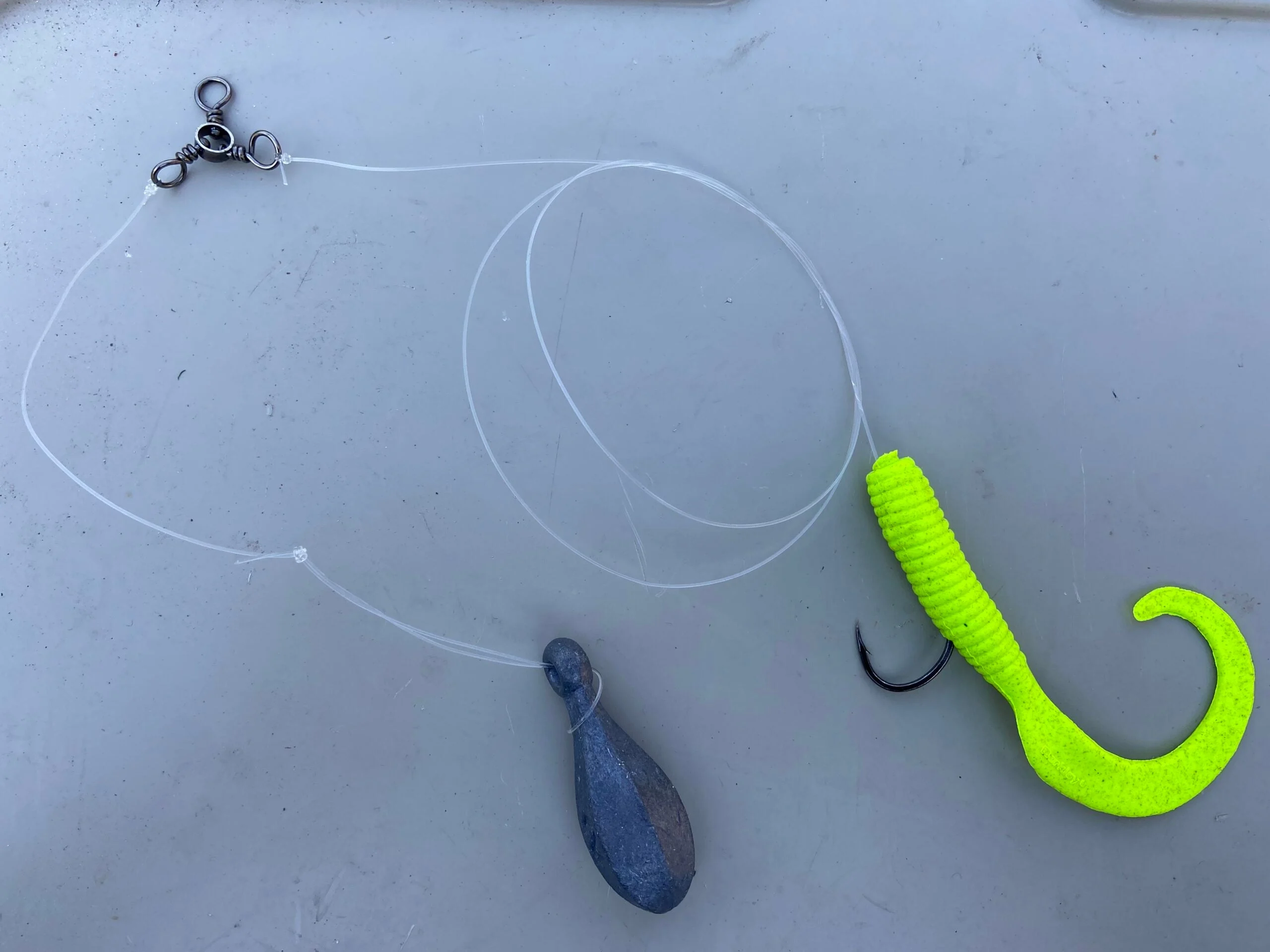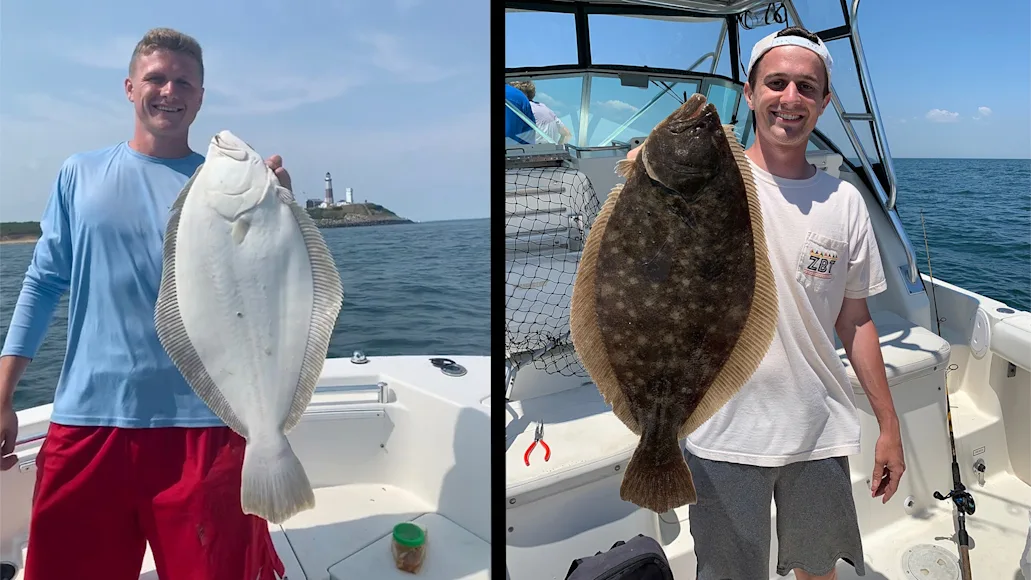_We may earn revenue from the products available on this page and participate in affiliate programs. Learn more ›
_
Fluke fishing brings back a flood of memories for me. My grandfather’s 1972 tri-hull bowrider was much better suited for water skiing than for fishing, but as a kid, I didn’t understand that or care. Going out on Barnegat Bay in New Jersey on Pop’s boat was a big-league adventure compared to worm dunking at the ponds and lakes closer to home, and the very first time he ever took me out at age 6, I caught a keeper fluke. It was, at the time, the pinnacle of my angling career, because it was the first fish I’d ever caught in saltwater
that we’d be bringing home for the table.
For a while, it seemed like fluke fishing would always be just that: a nice memory. But I’ve gotten back into it lately, and I’ll tell you why I’m happy I did. But first, let’s cover some fluke fishing basics.
Fluke Fishing: Table of Contents
What is a Fluke?
Getting Into Fluke Fishing
Best Baits and Tactics for Fluke Fishing
FAQs

The author’s brother-in-law shows off a nice fluke. Joe Cermele
What Is a Fluke?
Fluke is the Northeast name for northern flounder
, sometimes referred to as summer flounder. They range from Nova Scotia to Florida, though you’ll find most of the real fluke zealots roughly between Maryland and Massachusetts. In this area, party boats set out for them daily from late spring to early fall. Rental boats also shove off in droves, captained by vacationers hoping to secure fluke fillets for dinner.
The beauty of these flat fish is that they’re accessible in bays and close to shore in the ocean all summer long, and while countless articles have been written about hardcore fluke tactics for those seeking true trophies, the reality is they’re great for anglers all of ages and skill levels. For the last two years, I’ve been chasing them with kids and non-angling brother-in-laws almost every summer weekend, so I’ve had to pick up a few fluke fishing tricks to make sure everyone has a good time.
While I grew up chasing them, my attention shifted to bigger players like striped bass
and tuna as I got older. In my teens and 20s, I was way too cool to bottom bounce all day for “flatties.” That was for summer tourists and kids.
Fast forward to my late 30s, and I’ve now got a 5- and 8-year-old and a brand-new center console purchased by my golf-obsessed father-in-law tied up at his summer home. As the fishiest and most nautical member of the family, suddenly it was my duty to put the whole tribe on the meat. But it’s hard to take kiddos and people with a propensity for sea sickness 20 miles off for bluefin. So, I became a bay runner once again and, by default, a fluke hunter.
Getting Into Fluke Fishing
Each spring, fluke migrate from offshore where they spawn into bay systems. This means that right around Memorial Day—the unofficial kick-off of summer—you have the best opportunity to score jumbo fish without leaving the inlet throughout much of their range. As the water heats up over the next few months, many fish will run back out to the ocean, seeking cooler temperatures and more abundant forage, but even in the dog days of summer, plenty of them remain in the calmer, more protected waters of the bay.
Whether you’re running your own boat, renting one, or jumping on a back-bay party boat
, the trick to summer success is fishing close to inlets, as the exchange of cool ocean water with each tide will make the area more comfortable to the fish than far-inland reaches of the bay. As long as you’re fishing during a moving tide, so you have a good drift, you’re in the game.
Fluke “sharpies” will tell you precisely what point in the tide is perfect and how you have to hop a bucktail jig with a certain cadence over a certain hump or in a specific hole for the best success, and they’re not wrong. But getting a 5-year-old to understand that or trying to teach it to the less-fishy folks aboard can be difficult. Pin-point-accuracy fluking takes practice and focus, and while you might graduate to it later, I’ve found that with the family on the boat, it’s smarter to play the long game.
Nautical charts, maps provided by rental-boat outfitters, and a good GPS are all invaluable for fluking simply because you need to consider water depth. What you’re looking for are changes. For example, a deep main channel that slopes up to shallower water on either side is prime. Deep holes created by tidal flow around bridges are also excellent. As a rule, any marked and maintained channels within a bay system will hold fluke, and with youngsters and rookies fishing, I like to choose an area where I can make long drifts in the zone instead of short drifts that have me motoring back to the starting point over and over. In essence, I’d rather keep lines in the water longer and be able to help everyone with tangles and fighting fish than have to stay at the wheel for short, targeted drifts that might cause me to bump into a dock or get stranded in the shallows if I’m not paying attention.
Best Baits and Tactics for Fluke Fishing

The author’s basic rig for fluke fishing. This version shows a bank sinker, but a casting sinker works, too. Joe Cermele
As for what’s on the end of each line, all I can say is God bless Berkley Gulp!
These scented soft plastics have revolutionized fluke fishing, and they’re so potent it’s rare to see a fluke angler not incorporating them into his or her rig. The best part about them is that they have enticing action even when they’re just being dragged along the bottom, which—let’s be honest—is how a little kid will present a fluke rig 95 percent of the time. Try your best to explain the nuances of tapping a bucktail or hopping a spoon, but when you’ve got little ones out or folks who prefer to sit on the bow with a WhiteClaw in one hand and the rod in the other, they’re dropping to the bottom and calling it done.
My go-to rig with the family is simple. I’ll tie a three-way swivel
to the main line. From one eye, I’ll run an 18-inch length of 20-pound fluorocarbon
to a size 2/0 octopus hook
. To the remaining eye, I’ll tie a 6- to 8-inch length of 10-pound leader and add a casting sinker
or bank sinker heavy enough to hold bottom depending on the speed of the drift. Anglers will argue for days about the best Gulp styles and colors for fluke, but I’m partial to 5-inch Saltwater Grub
in Nuclear Chicken and Salmon Red. Simply thread one onto the hook, let the sinker touch down, and no matter how much or how little the angler is paying attention, that grub is flapping away as the sinker kicks puffs of mud and sand. Is this the most complex fluke rig ever? No, but it’s hooked piles of fish on my son’s rod while sitting in the holder because he needed a snack. It has made my brother-in-law beach-house heroes again and again, and the way I see it, the more fish they catch, the more interested they become in learning more advanced strategies as time goes on.
FAQs
Q: Are fluke and flounder the same thing?
Fluke and summer/northern flounder are the same fish. However, winter flounder is a different subspecies, which are found in the same waters as fluke, but are smaller in size.
Q: Is fluke good to eat?
Yes. Fluke are excellent table fare.
Q: What is the best time of day to fluke fish?
The best time to target fluke has more to do with the tide than the time of day. The start or end of a tide change usually produces some of the best fishing.


